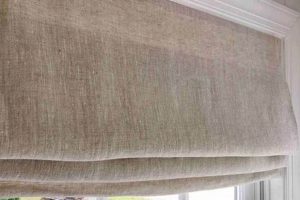A mixture prepared at home intended for cleansing carpets is designed to remove stains, dirt, and odors from carpeting fibers. These formulations typically utilize common household ingredients such as vinegar, baking soda, dish soap, and water. For example, a solution combining water, white vinegar, and a small amount of dish soap can act as a stain remover when applied to affected areas.
The value of these homemade cleansing agents lies in their accessibility, cost-effectiveness, and environmentally conscious approach. They often bypass the need for purchasing specialized commercial products containing potentially harsh chemicals. Historically, reliance on readily available household items for cleaning purposes predates the widespread availability of commercial cleaners, signifying a return to more sustainable and economical practices.
The following sections will delve into the specific recipes, application techniques, and safety considerations involved in effectively using a homemade carpet cleanser. Additionally, the article will explore the limitations of this approach and when professional carpet cleaning services may be necessary.
Effective Application Techniques
This section provides guidance on maximizing the effectiveness of homemade carpet cleansers. Adherence to these principles will enhance stain removal and improve overall carpet hygiene.
Tip 1: Pre-Treatment is Essential: Prior to applying any cleansing agent, thoroughly vacuum the carpeted area. This removes loose debris and surface-level dirt, allowing the solution to penetrate the fibers more effectively.
Tip 2: Spot Test in an Inconspicuous Area: Before applying any solution to a large or visible area, test it on a small, hidden section of the carpet. This ensures the solution does not cause discoloration or damage to the carpet fibers.
Tip 3: Apply Sparingly and Evenly: Avoid saturating the carpet with the cleansing agent. Over-wetting can lead to mold growth and prolong drying time. Use a spray bottle or sponge to apply the solution evenly to the affected area.
Tip 4: Agitate Gently for Deep Cleaning: After applying the solution, use a soft-bristled brush or clean cloth to gently agitate the fibers. This helps to loosen embedded dirt and stains.
Tip 5: Allow Adequate Dwell Time: Permit the cleansing agent to dwell on the treated area for the recommended time period, typically 10-15 minutes. This allows the solution to break down stains and odors effectively.
Tip 6: Blot, Do Not Rub: When removing the solution, blot the area with a clean, dry cloth. Rubbing can spread the stain and damage the carpet fibers.
Tip 7: Rinse Thoroughly: After blotting, rinse the treated area with clean water to remove any residual solution. This prevents residue buildup that can attract dirt.
Tip 8: Dry Completely: Ensure the carpet is thoroughly dry after cleaning. Utilize fans or open windows to facilitate air circulation and expedite the drying process.
By implementing these techniques, individuals can increase the success rate of homemade carpet cleansers and maintain the cleanliness and appearance of their carpets.
The following sections will address safety precautions and alternative cleaning methods for specific types of carpet stains.
1. Ingredient Selection
The selection of ingredients forms the cornerstone of any homemade carpet cleaning agent. The effectiveness of such a solution is directly proportional to the suitability of its components for the specific cleaning task and the type of carpet being treated. Inappropriate ingredient selection can lead to ineffective cleaning, damage to the carpet fibers, or even health hazards. For example, using an alkaline cleaning agent, such as baking soda, on a wool carpet, which is composed of protein fibers, can lead to fiber degradation. Conversely, an acidic solution, like vinegar, is more appropriate for certain stains but may be unsuitable for alkali-sensitive carpets.
Consider a scenario involving a pet urine stain on a synthetic carpet. An effective approach involves a solution containing enzymatic cleaners to break down the organic compounds responsible for the stain and odor. Simply using a mixture of water and dish soap might remove the visible stain but fail to address the underlying odor, potentially attracting the pet back to the same spot. Moreover, the pH level of the selected ingredients must be appropriate to avoid discoloration or bleaching of the carpet. The wrong concentration of vinegar, for instance, could lighten the carpet’s color, particularly if it’s a dyed fabric.
Therefore, a careful assessment of the stain type, carpet fiber composition, and chemical properties of the intended cleaning agents is crucial. Proper ingredient selection is not merely a preference but a necessity for achieving safe, effective, and long-lasting cleaning results when employing homemade carpet cleaning solutions. Failure to prioritize this aspect can result in damage to the carpet, persistent odors, and the potential need for professional intervention.
2. Solution Concentration
The concentration of a homemade carpet cleaning solution directly influences its effectiveness and safety. A solution that is too dilute may prove ineffective at removing stains and odors, whereas an overly concentrated solution risks damaging carpet fibers, leaving behind residue, or causing discoloration. The principle of cause and effect is evident: insufficient concentration yields inadequate cleaning, while excessive concentration can lead to irreversible harm. The precise balance between these extremes underscores the importance of careful measurement and adherence to recommended dilution ratios when formulating a homemade cleanser. For instance, a solution using too much vinegar, intended to combat odors, could, in reality, degrade the carpet’s dye, resulting in a bleached appearance. Conversely, a solution lacking sufficient cleaning agent may only address surface dirt, failing to penetrate and eliminate embedded stains.
Practical application involves understanding the specific properties of each ingredient and its interaction with the carpet fibers. Different types of stains necessitate varying concentrations of cleaning agents. For example, a grease stain might require a slightly higher concentration of dish soap, while a water-based stain could respond well to a more diluted solution of vinegar and water. Moreover, the material composition of the carpet influences the appropriate concentration; delicate fibers, such as wool or silk, demand significantly more diluted solutions compared to more resilient synthetic fibers like nylon or olefin. Precise measurement tools, such as measuring cups and spoons, are indispensable for ensuring consistent and safe results. The order in which components are mixed can influence the a
ctivity of the components.
In summary, the concentration of a homemade carpet cleaning solution is a critical determinant of its success. Maintaining a balanced concentration is essential. Challenges in achieving this balance arise from the variability in stain type, carpet fiber, and the inherent lack of standardization in homemade recipes. Ultimately, understanding the interplay between these elements is pivotal for effectively and safely leveraging homemade carpet cleaning solutions, linking directly to the broader goal of responsible and sustainable home maintenance.
3. Carpet Fiber Type
The selection of a suitable homemade carpet cleaning agent is inextricably linked to the type of fiber comprising the carpet. An ill-chosen solution can result in irreversible damage, discoloration, or premature wear. Understanding the characteristics of different carpet fibers is therefore paramount before applying any cleaning treatment.
- Natural Fibers: Wool
Wool, a protein fiber, is susceptible to damage from alkaline solutions. High pH cleaners can degrade the fibers, causing them to become brittle and lose their natural luster. Homemade solutions for wool should be pH-neutral or slightly acidic, utilizing ingredients such as diluted white vinegar. Harsh chemicals like bleach are strictly prohibited.
- Natural Fibers: Cotton
Cotton carpets, while generally more durable than wool, are prone to shrinking and water staining if excessively wet. Homemade solutions should be applied sparingly, and thorough drying is essential. The use of a dehumidifier or fans to accelerate the drying process is recommended to prevent mildew growth.
- Synthetic Fibers: Nylon
Nylon carpets are relatively resilient and can tolerate a wider range of cleaning solutions. However, it’s still crucial to avoid harsh chemicals that may cause discoloration or fiber degradation over time. A mild, pH-balanced solution, such as a mixture of water and a small amount of dish soap, is typically sufficient.
- Synthetic Fibers: Olefin (Polypropylene)
Olefin carpets are highly stain-resistant but can attract oily soils. Homemade solutions should include a degreasing agent, such as a small amount of citrus-based cleaner. Testing in an inconspicuous area is especially important, as some cleaning agents can alter the color of olefin fibers.
The interplay between carpet fiber type and the composition of homemade cleaning solutions dictates the outcome of the cleaning process. Ignoring this relationship can lead to undesirable results, necessitating costly repairs or replacements. A thorough understanding of fiber characteristics is therefore essential for effective and safe carpet maintenance.
4. Pre-Cleaning Vacuuming
Pre-cleaning vacuuming is a foundational step when utilizing homemade carpet cleaning solutions. Its efficacy is directly dependent on the degree to which loose particulate matter is removed prior to the application of any liquid cleaning agent. Failure to adequately vacuum before applying a solution diminishes the solution’s ability to effectively target embedded stains and dirt, impacting the overall cleaning outcome.
- Removal of Loose Debris
Vacuuming extracts loose dirt, dust, hair, and other debris from the carpet fibers. This prevents these particles from dissolving or becoming suspended in the cleaning solution, which could then create a muddy residue. Imagine attempting to clean a heavily soiled car without first rinsing off the loose dirt; the same principle applies to carpet cleaning. Adequate vacuuming ensures the cleaning solution can directly address the adhered stains rather than being consumed by surface-level detritus.
- Improved Solution Penetration
When loose debris is removed, the homemade cleaning solution can penetrate deeper into the carpet fibers. This deeper penetration allows the cleaning agents to effectively break down and lift embedded stains and odors that would otherwise remain untouched. For example, attempting to remove a ground-in coffee stain without pre-vacuuming would result in the solution merely spreading the stain rather than lifting it from within the fibers. Enhanced penetration directly translates to improved stain removal.
- Prevention of Fiber Damage
Vacuuming removes abrasive particles that can damage carpet fibers when agitated by the cleaning process. These particles, if left in place, can act like sandpaper when scrubbed with a brush or cloth, leading to premature wear and tear. Effective pre-cleaning vacuuming minimizes this abrasion, prolonging the life of the carpet fibers. Think of it as removing small stones from a shoe before walking a long distance; the absence of the stones prevents blisters (fiber damage).
- Minimizing Residue
Properly vacuuming the space helps minimize the leftover residue. By removing loose debris, the need for excessive amounts of cleaning agent can be avoided, which in turn reduces the amount of residue to manage in the follow-up. When there is less residue, there are fewer chances of the surface attracting even more dust and debris in a short amount of time.
In summary, pre-cleaning vacuuming directly enhances the effectiveness of any homemade carpet cleaning solution. This preparatory step optimizes solution penetration, protects carpet fibers from damage, and reduces the amount of residue. Adherence to this practice is essential for achieving optimal cleaning results and maintaining the longevity of carpeted surfaces. Effective pre-cleaning creates the conditions where the solution can perform and clean effectively.
5. Spot Testing Imperative
Before the widespread application of any homemade carpet cleaning solution, conducting a spot test in an inconspicuous area is a non-negotiable prerequisite. This procedure serves as a critical safeguard, preventing potential damage or discoloration to the carpet fibers and ensuring the suitability of the chosen cleaning agent for the specific material.
- Assessment of Colorfastness
The primary purpose of a spot test is to evaluate the colorfastness of the carpet. Homemade solutions, due to their varying compositions and pH levels, may cause dyes to bleed, fade, or undergo undesirable color changes. By applying the solution to a hidden area and observing its effects over a period of time (typically 24 hours), one can ascertain whether the solution is likely to compromise the carpet’s original coloration. If color bleeding is observed, the solution is deemed unsuitable.
- Evaluation of Fiber Integrity
Certain homemade solutions may contain ingredients that, while effective at stain removal, can also weaken or damage carpet fibers. A spot test allows for the assessment of fiber integrity by observing whether the solution causes the fibers to become brittle, matted, or otherwise compromised. Damage manifests as a change in texture or physical integrity after the solution dries. The absence of such damage indicates the solution is likely safe fo
r broader use. - Detection of Residue Buildup
Some homemade solutions, particularly those containing excessive amounts of soap or detergent, may leave behind a sticky or oily residue, attracting dirt and causing the carpet to become soiled more quickly. A spot test enables the detection of this residue by observing whether the tested area becomes noticeably stickier or attracts more dirt than the surrounding carpet over time. The presence of residue indicates a need to modify the solution or reconsider its suitability.
- Allergic or Irritant Reaction Identification
Although less common for homemade solutions, a spot test can help identify an allergic or irritant reaction to any of the components used in the solution. If the person doing the testing experiences skin irritation, breathing difficulty, or any other allergy-related symptoms, the solution must be discarded immediately. This ensures the safety and well-being of the people occupying the space.
The insights gained from a spot test inform the decision-making process regarding the suitability of a homemade carpet cleaning solution. If the spot test reveals any adverse effects, alternative cleaning methods or modifications to the solution’s composition should be explored. Neglecting this imperative step introduces unnecessary risks and can result in irreversible damage to the carpet, underscoring the importance of diligent testing before embarking on a full-scale cleaning endeavor. It is not an option, but a must for maintaining a carpet’s overall health.
6. Drying Thoroughly
The imperative of thorough drying following the application of any homemade carpet cleaning solution cannot be overstated. Inadequate drying fosters an environment conducive to microbial growth, odor retention, and potential damage to carpet fibers, negating the intended benefits of the cleaning process.
- Prevention of Mold and Mildew Growth
Residual moisture within carpet fibers creates an ideal breeding ground for mold and mildew. These organisms thrive in damp, dark environments, and their presence can lead to health problems, including respiratory issues and allergic reactions. Proper drying, employing methods such as ventilation, fans, or dehumidifiers, inhibits the proliferation of these microorganisms, safeguarding indoor air quality and preventing structural damage to the carpet backing.
- Elimination of Residual Odors
Carpet fibers, when damp, tend to retain odors. Lingering moisture can reactivate existing odors or even generate new ones, effectively undermining the odor-removing properties of the cleaning solution. Thorough drying ensures the complete evaporation of moisture, preventing the entrapment of odor molecules within the fibers and promoting a fresh, clean scent.
- Mitigation of Fiber Degradation
Prolonged exposure to moisture can weaken carpet fibers, particularly natural fibers like wool or cotton. Dampness can cause fibers to swell, lose their structural integrity, and become more susceptible to damage from abrasion or wear. Expedited drying minimizes this risk, preserving the strength and durability of the carpet fibers and extending the carpet’s lifespan.
- Prevention of Re-Soiling
A damp carpet is essentially a magnet for dirt and dust. The moisture will attract more dirt, both from the air and people’s feet, causing the surface to re-soil far faster than it would have otherwise. By removing any excess moisture, you prevent the carpet from being a magnet. This will help the surface remain cleaner for longer.
The multifaceted benefits of thorough drying are integral to the successful implementation of homemade carpet cleaning solutions. From preventing microbial growth to preserving fiber integrity, this step is essential for maximizing the efficacy of the cleaning process and ensuring the long-term health and appearance of the carpet.
7. Residue Removal
Residue removal is a critical phase following the application of any homemade carpet cleaning solution. Failure to adequately remove cleaning solution residue can negate the intended benefits of the cleaning process, resulting in accelerated resoiling, fiber damage, and potential health concerns. The cause-and-effect relationship is straightforward: residual cleaning agents attract dirt, leading to rapid resoiling, and, in some cases, can cause allergic reactions in sensitive individuals. The presence of residue creates a sticky surface, effectively turning the carpet into a dirt magnet. The significance of residue removal as an integral component of homemade carpet cleaning is that it ensures long-term cleanliness and prevents the accumulation of grime, which can degrade the carpet’s appearance and longevity. For example, a baking soda residue left after a cleaning attempt can gradually accumulate and, over time, cause a dull, white film on the carpet surface, altering its color and texture. This underscores the practical necessity of thorough residue extraction.
Effective residue removal involves several techniques, depending on the nature of the cleaning solution used. Blotting with clean, absorbent cloths is a primary method for extracting excess solution. Rinsing the cleaned area with clean water, either manually or using a carpet cleaning machine, is another essential step. The water dilutes and lifts the remaining cleaning agent, facilitating its removal. The method of blotting, rinsing and then vacuuming with adequate ventilation is key to optimal results. In situations where a significant amount of residue is suspected, a specialized residue-removing solution, specifically designed for carpet cleaning, may be necessary. For instance, after using a vinegar-based cleaning solution, a plain water rinse is typically sufficient. However, after using a solution containing soap, a more thorough rinsing process, potentially with a low-residue carpet cleaner, is advisable. Each technique must be applied with precision, and thoroughness is key.
In summary, residue removal is not a mere afterthought but a fundamental step in the process of DIY carpet cleaning. Its impact on the cleanliness, appearance, and longevity of the carpet is substantial. Challenges arise from the variability in homemade solution recipes and the differing absorption rates of various carpet fiber types. However, by employing appropriate techniques and paying meticulous attention to detail, successful residue removal can be achieved. As such, the effectiveness of any homemade carpet cleaning solution is intrinsically tied to the diligence with which residue removal is executed.
Frequently Asked Questions
This section addresses common inquiries and misconceptions surrounding the formulation and application of homemade carpet cleaning solutions. Information presented aims to provide clarity and promote safe and effective cleaning practices.
Question 1: Can household vinegar effectively clean carpets?
Household vinegar, specifically white distilled vinegar, possesses mild acidic properties that can aid in stain removal and odor neutralization. Its effectiveness is contingent on the stain type and carpet fiber. Vinegar is most suitable for water-based stains and may be less effective on grease or oil-based stains. Dilution is essential to prevent damage to certain carpet fibers, particularly natural fibers lik
e wool.
Question 2: Is baking soda safe for all carpet types?
Baking soda is generally considered safe for most carpet types. It acts as a deodorizer and can help loosen dirt and absorb moisture. However, prolonged contact with baking soda may cause damage to delicate fibers. Thorough removal of baking soda residue is crucial to prevent a powdery buildup and potential discoloration.
Question 3: Will homemade solutions damage my carpet’s stain resistance?
Certain homemade cleaning solutions, especially those containing harsh chemicals or abrasive ingredients, can compromise a carpet’s stain-resistant treatment. It’s advisable to spot test any solution in an inconspicuous area before widespread application. Avoiding excessive scrubbing and harsh chemicals can help preserve stain resistance.
Question 4: How frequently can a homemade carpet cleaning solution be used?
The frequency of use depends on the amount of foot traffic and the propensity for staining. Over-cleaning, even with gentle solutions, can lead to fiber wear and tear. It is recommended to clean carpets only as needed, addressing spills and stains promptly to minimize the need for frequent overall cleaning.
Question 5: What safety precautions are necessary when using homemade cleaning agents?
When working with homemade cleaning solutions, it is advisable to wear gloves to protect the skin. Ensure adequate ventilation to avoid inhaling fumes, particularly when using vinegar or ammonia. Keep cleaning solutions out of reach of children and pets. Thoroughly rinse and dry the carpet after cleaning to remove any residual cleaning agents.
Question 6: Are there stains for which professional cleaning is always recommended?
Certain stains, such as those from blood, red wine, or pet urine, often require professional cleaning for complete removal and odor elimination. These stains can deeply penetrate the carpet fibers and may require specialized equipment and cleaning agents to effectively treat.
These FAQs serve to highlight the importance of careful consideration and informed decision-making when utilizing homemade carpet cleaning solutions. Safety, fiber compatibility, and stain type are key factors to consider.
The subsequent section will explore specific recipes for different types of carpet stains and the appropriate application techniques.
diy carpet cleaning solution
This exploration has underscored the nuances inherent in employing a diy carpet cleaning solution . Key considerations include meticulous ingredient selection, appropriate solution concentration, and compatibility with the carpet’s fiber type. Rigorous pre-cleaning vacuuming and the imperative of spot testing are crucial for mitigating potential damage. Equally vital are thorough drying and meticulous residue removal to prevent microbial growth and accelerated resoiling.
Given the complexities outlined, individuals must carefully weigh the benefits of cost savings and environmental consciousness against the potential risks of ineffective stain removal or irreversible carpet damage. The informed application of a diy carpet cleaning solution requires diligence and a commitment to best practices, ensuring a balance between economic prudence and the long-term preservation of carpeted surfaces. Ultimately, the decision rests on a comprehensive evaluation of resources, expertise, and the specific demands of the cleaning task.







